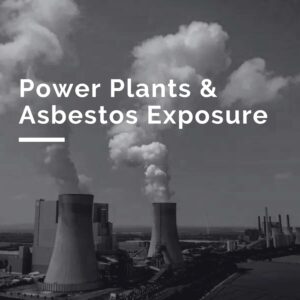What had a simple beginning from Benjamin Franklin’s invention of electricity, turned into a state-wide operation of power plants. These power plants range from several different types such as “fossil fuels, nuclear, biomass, geothermal, and solar thermal energy” (“Electricity in the U.S. – U.S. Energy Information Administration (EIA)”). These power plants employed thousands of workers putting them at risk of working with asbestos materials. The operational process of power plants, which uses fuel to heat water and produce steam for electricity, puts different departments at risk of asbestos exposure. Power Plants and asbestos exposure were common.

Asbestos is a naturally occurring mineral that is the term for six different types of fibers. These fibers range in color, shape, and property but all are hazardous when inhaled or consumed. Penn Medicine describes these fibers as:
- Actinolite asbestos (found in cement and insulation materials)
- Amosite asbestos (brown and found in construction materials)
- Anthophyllite asbestos (found in cement and insulation materials)
- Crocidolite asbestos (blue and found in cement in insulation)
- Tremolite asbestos (no longer used but found in sealants and plumbing materials)
- Chrysotile asbestos ( white and most associated with ingestion)
Given its heat and fire-resistant properties it was commonly used in building materials. This includes items like heat-resistant fabrics, textured paints, pipes, flooring, and roofing.
The coal power plant industry once boomed before the additional discoveries of energy were made. This was before the discoveries by the Environmental Protection Agency and public awareness of the dangers of these plants. However, during the growing phase of this fossil fuel industry, A surge in materials was needed to keep up with the increase in energy consumption. This began when electricity started to power more buildings and homes in the 1920s, which required a cost-efficient material to serve in these plants.
The workers at high risk of being frequently exposed to this mineral are metal workers and electricians. These individuals were often working closely with hot water pipes, furnaces, and steam pipes meaning the asbestos insulation surrounding these materials. This often occurred when maintenance was being done to these pipes or furnaces. The National Library of Medicine suggests that some of the activities that could have occurred to release the asbestos into the air include:
- Removal of old insulation
- Disposal of insulation materials
- Assembling of asbestos mixtures
- Installation of asbestos materials
The exposure amount experienced by these workers exceeded the Occupational Safety and Health Administration’s permissible exposure amount and eventually, these companies were required to follow more restrictions and protective measures. Some of the companies eventually filed for bankruptcy after asbestos was recognized to be hazardous. As a means to protect themselves from lawsuits, companies sought bankruptcy under the condition of creating an asbestos-related trust fund for workers and families impacted by the exposure. The list includes:
- Plant Insulation Co.
- General Motors Corp.
- Thorpe Insulation Co.
- Additional companies can be found here
Unfortunately, while the mineral was useful for insulation in these plants, the workers were in danger of asbestos exposure. When this occurs, the asbestos contaminates the air and can be easily inhaled. The mineral then travels through the body and the fibers begin to “irritate and scar lung tissue”. Whether in large doses or small, asbestos can have lasting effects on the individuals working with, living nearby, or sharing a residence with one of the workers of this industry. This exposure brings great danger as the latency period of any asbestos-related disease typically runs from 20-40 years after exposure, leaving little room for survival after a diagnosis.
If exposed to asbestos, there is the risk of diagnoses such as mesothelioma, and asbestosis. The rarest of them all is mesothelioma. While there are roughly 3,000 diagnoses each year in the United States, the type of cancer is rare and attacks the mesothelial cells. The cells are found in the tissue of vital organs such as the lungs, named pleural mesothelioma, the abdomen, named peritoneal mesothelioma, the heart, named pericardial mesothelioma, and the testicles, named testicular mesothelioma. As mentioned previously, the long latency period can make it difficult to diagnose the cancer as the earlier symptoms can often be misinterpreted as something far less intimidating. The gateway symptoms include chest pain, coughing, and difficulty breathing which can all fall under respiratory issues. Unfortunately, while survival is possible, it is extremely rare, leaving roughly 4 to 18 months of survival following diagnosis.
Asbestosis is another disease followed by asbestos exposure. This diagnosis is more familiarly recognized as a chronic lung disease, which presents symptoms like chest pain, persistent cough, or shortness of breath. However, one of the unique identities of asbestosis is clubbing of the fingers which results in wide and round fingertips. When the asbestos is inhaled for a long period at large doses, scarring of the lung tissue can occur. In this condition, the duration and frequency of exposure put the worker at a higher risk of severity. Additionally, there is currently no cure for asbestos and it can only be treated to assist with symptom relief and growth.
Plant workers who have been exposed and experienced symptoms of an asbestos-related disease could be eligible for financial compensation. If you or someone you know has been affected by asbestos exposure or mesothelioma in the state of Pennsylvania, please visit The Halpern Law firm for a free consultation or call 1 (800) 505-6000 to turn today’s adversity into tomorrow’s justice
Sources:
https://www.eia.gov/tools/faqs/faq.php?id=65&t=2
https://www.nationalgrid.com/stories/energy-explained/history-energy-united-states
https://www.mayoclinic.org/diseases-conditions/asbestosis/symptoms-causes/syc-20354637#
https://www.lung.org/lung-health-diseases/lung-disease-lookup/asbestosis/symptoms-diagnosis
https://www.lung.org/lung-health-diseases/lung-disease-lookup/asbestosis/learn-about-asbestosis
https://www.ncbi.nlm.nih.gov/pmc/articles/PMC4457122/